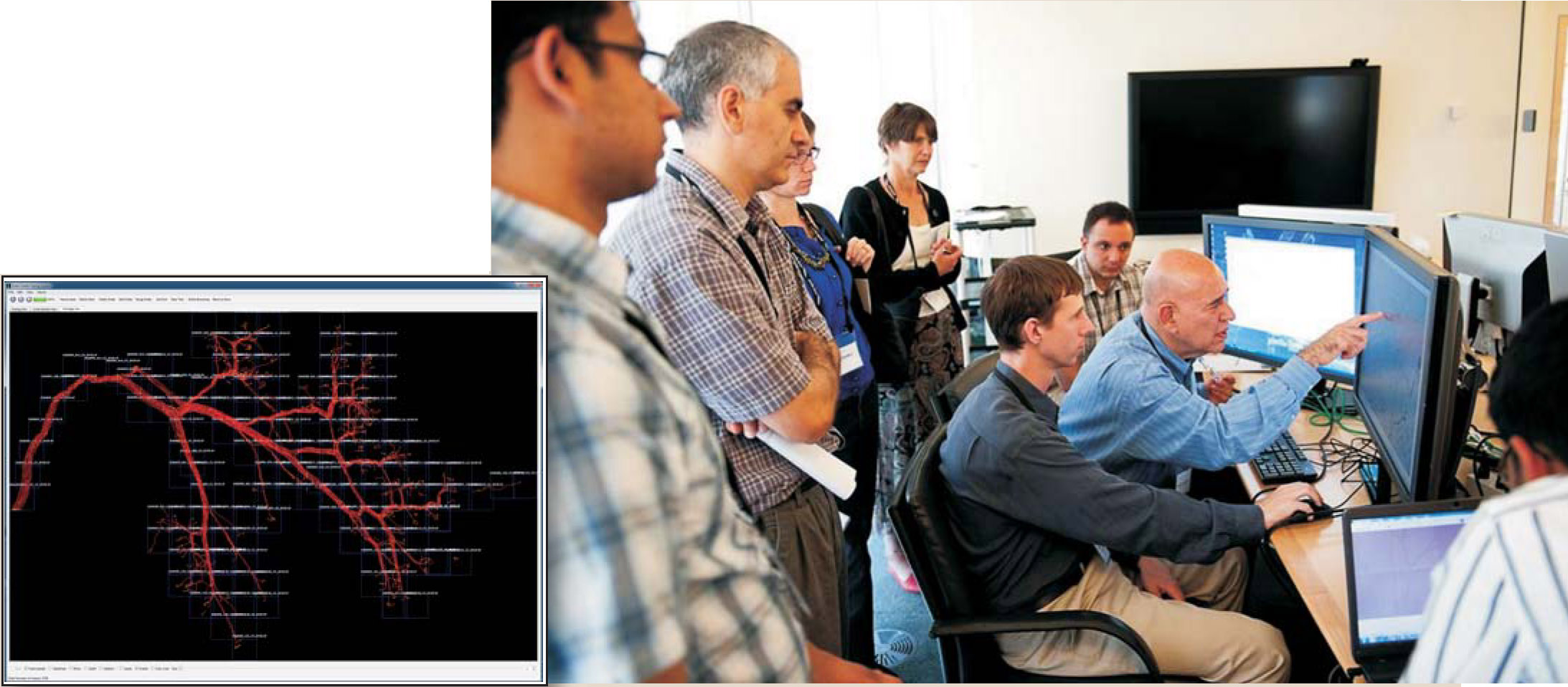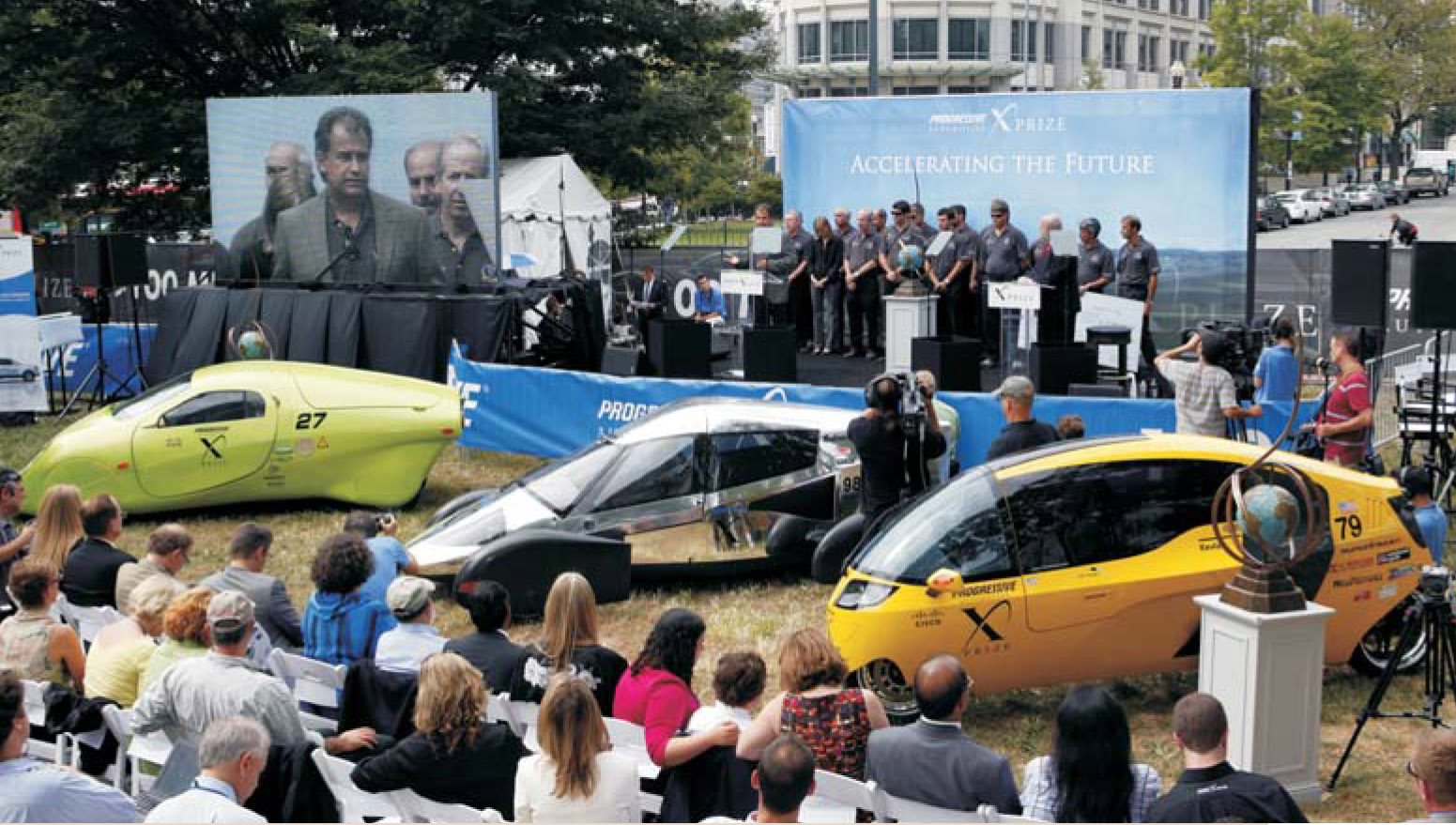Incentive prizes reinvented to solve problems
DOI: 10.1063/1.3518202
Every keystroke counted during the face-off of the Digital Reconstruction of Axonal and Dendritic Morphology (Diadem) Challenge. In late summer, five teams of finalists gathered for three days at the Howard Hughes Medical Institute’s (HHMI’s) Janelia Farm Research Campus in Virginia to pit their algorithms against each other. “They had us in a glass-enclosed room. They timed us with stopwatches,” says the University of Houston’s Badri Roysam, who develops computer vision systems for biology. Roysam led one of the four teams that split the $75 000 purse that HHMI, the Allen Institute for Brain Science, and the Krasnow Institute for Advanced Study at George Mason University (GMU) offered for automated tracing of single neurons.
Until now, neuronal morphology has been mapped mostly by hand. Tracing a single neuron involves analyzing hundreds of stacks of microscopy images—with each stack being a series of two-dimensional images that form a 3D reconstruction at a particular spot. The process takes days or even weeks of a graduate student’s time. One of the data sets in the final round of the Diadem Challenge consisted of 14 000 images. The commercial software products available so far haven’t proved satisfactory. The Diadem Challenge grew out of a discussion during which experimentalists dreamed of creating a cellular map of the brain, says GMU’s Giorgio Ascoli, who proposed and was an organizer of the competition. “All the computer people said, we can do this already. And all the neuroscientists said, no, you can’t.’
The challenge attracted more than 100 teams of computer scientists, engineers, and physicists. None of the finalists met the stated goal of a 20-fold speed-up in tracing for three out of five data sets, but a 10-fold increase was achieved in some cases. The difficulties lay largely in the variety of methods used to collect data, including different labeling techniques and different forms of microscopy.
Still, everyone involved agrees the challenge was a success. One goal was to bring data producers and programmers together “to initiate a feedback loop,” says Karel Svoboda, a Janelia Farm scientist and co-organizer of the Diadem Challenge. “The algorithm producers will tell experimentalists that there are features [in the data] that are damaging to the algorithms, and some may be easy to fix. This is a first step.” The challenge, he adds, “has a catalyst function. It gets the competitive juices flowing and produces focused work.’
Prizes that, like the Diadem Challenge, aim to motivate people to solve a specific problem are on the rise. According to a 2009 report by the consulting firm McKinsey and Co, the total number of prizes offered is going up and the number of incentive prizes—as opposed to Nobel and other retrospective prizes, which recognize past work—is growing fast. Before 1991, 97% of the total value of big-prize purses in the McKinsey analysis was dedicated to recognizing prior achievement. By 2009, 78% of such prize money was for incentive, or inducement-style, prizes. Moreover, prizes focused on climate, the environment, science and engineering, and aviation and space increased sevenfold in the past decade, and most of the money goes to those who solve predefined problems.
Longitude, canning, comets
Historically, incentive prizes were popular. Among the most well known are the longitude prize launched in 1714 by the British government and a series of prizes offered during the French Revolution for food-related advances that led to large-scale processing of beet sugar, a canning method that is still in use today, and other inventions. “There was beet sugar before, but a big prize from the emperor [Napoleon] focuses the mind, and people found a way to make it commercial,” says Deborah Warner, a curator of the history of science at the Smithsonian Institution’s National Museum of American History. Often, she notes, such prizes bring more glory to the prize-givers than to the inventors or discoverers who win them.
In 1847 Maria Mitchell of Nantucket, Massachusetts, discovered a comet and duly collected a gold medal on offer from King Frederick VI of Denmark. An amateur astronomer, she would have been looking at the skies in any case, says Warner. But the prize did boost her academic career: Some years later, she was the first faculty member appointed by Vassar College. And Charles Lindbergh’s 1927 pioneering flight across the Atlantic was motivated by the $25 000 offered by New York hotel owner Raymond Orteig.
In Europe in the 18th and 19th centuries, scientific societies regularly offered prizes for solving theoretical and applied problems of the day; mathematician and physicist Leonhard Euler, for example, won a dozen such prizes. But incentive prizes largely died off after the French Revolution, once science moved from learned societies to universities and royal and aristocratic patronage waned. Jeremy Gray, a historian of mathematics at the UK’s Open University, says that in trawling through the literature “you see prizes extended and ultimately awarded for something else. It looks like the prizes didn’t have enough cachet” to focus people’s research.
Peter Diamandis, founder and CEO of the nonprofit X Prize Foundation, which creates, manages, and finds sponsors for prizes with the aim of bringing about radical breakthroughs for the benefit of humanity, says many prizes were offered in the US in the early decades of the 20th century. “When you put up a prize, there is fixed money and objective, and you leave time as a variable. Then World War II came along, and the Defense Department needed innovation on a schedule. Money didn’t matter.” Large corporations “became enamored” of the influx of money for research, he adds, and incentive prizes for innovations faded. Today’s grants system, and the likes of the MacArthur Fellows Program “genius awards,” hearken back to medals that were given in 18th-century Europe to support scientists with proven track records.
Crazy ideas
In recent years, though, incentive prizes have come back with a bang, inspired at least in part by the Ansari X Prize, the X Prize Foundation’s inaugural prize, which in 1996 promised $10 million to the first private team to send a spacecraft with three people aboard to an altitude of 100 km twice in a two-week period; the prize was awarded in 2004. Meanwhile, in 2000 the Clay Mathematics Institute in Cambridge, Massachusetts, launched its $1 million prizes for solutions to seven “millennium” problems.
Incentive prizes are effective for certain types of problems, says Diamandis, whose foundation this summer awarded the $10 million Progressive Insurance Automotive X Prize for safe cars that get the equivalent of 100 miles to the gallon or better, and—in the wake of the BP drilling-platform explosion in the Gulf of Mexico last spring—launched a $1.4 million challenge to develop speedier methods of cleaning the sea surface after oil spills. Suitable problems, he says, have a clear metric to meet or exceed. And in areas “where things are stuck, prizes are a no-lose option.” He points to the US Department of Defense’s Defense Advanced Research Projects Agency (DARPA) Grand Challenge for autonomous vehicles. From 1980 to 2000, the DOD spent well over $200 million trying to create autonomous vehicles, says Diamandis. “They had very little success. After 9/11 it got urgent, and they launched the prize.” In the second year, a group of Stanford University graduate students created a robotic car that was “leaps and bounds beyond what DOD had previously done. And they did it [spending only] $500 000.’
Now, he notes, DOD is using elements of the Stanford robotic car, and Volkswagen, a backer of the project, has implemented technologies from the winning car to assist steering, braking, and parking.
Besides tackling societal problems and achieving seemingly impossible feats, says Diamandis, “sometimes incentive prizes are useful in areas where there is a stigma. For example, it might be interesting to look at zero-point energy, cold fusion. We [at the X Prize Foundation] have talked about whether there is something [worth pursuing] on the fringe side of science. But it would require a benefactor who was interested.” The foundation, he says, “is constantly looking at what is radical and far enough out that we would accelerate the future or change behavior with a prize.” Diamandis likes to say that “the day before something is a breakthrough, it’s a crazy idea.’
Effective and high-impact
The US government is keen to be in on the action. Robynn Sturm at the White House Office of Science and Technology Policy co-leads a group that aims to make it easier for funding agencies to offer prizes. “We are helping to break down legal and administrative barriers and to build expertise about what sort of problems to use prizes for, and how to design prizes to be effective and high-impact,” she says.
This past March the Office of Management and Budget sent a memo to all federal agencies urging them to use incentive prizes to spur innovation and solve tough problems. The administration wants prizes to be “among the standard tools in every agency’s toolbox,” says Sturm, but “in no way sees [them] as a substitute for funding fundamental research.’
In September the White House launched http://challenge.gov
Reauthorization Act pending in the Senate includes a provision to further empower public-sector use of prizes to spur innovation.
Among the advantages of using prizes and challenges is that the sponsor pays only for success. The money spent on research spurred by challenges—from the Diadem to the Ansari X Prize—far exceeds the prize purses. Solvers, as they are often called, have to find other sources of funding to participate.
Prizes also “allow the government to articulate a bold goal without having to select a team or an approach,” says Sturm. Grant decisions typically favor “applications that promise incremental steps over those with potential to give rise to disruptive innovation,” she says. Prizes also increase the number and diversity of people who tackle problems.
Besides the advantages of stretching money and pulling in talent, technology is driving the comeback in incentive prizes. Growth in nanotechnology, biotechnology, robotics, and other “key technologies” is, Diamandis says, “effectively enabling small groups of people to do what only large corporations could do before.” And, he adds, “You don’t see Boeing or Northrop Grumman participating in the challenges, but you do see them come in afterwards and buy scale composites” for possible incorporation of challenge-generated ideas into their products.
For the right set of problems, prizes are incredibly powerful, says Diamandis. “I fundamentally believe that every challenge we face as a species can be overcome by the committed and passionate human mind.’

A typical scene at the Digital Reconstruction of Axonal and Dendritic Morphology Challenge face-off. Armen Stepanyants (standing, arms folded), a biophysicist from Northeastern University, led one of the winning teams. Data provider German Barrionuevo (touching screen) of the University of Pittsburgh’s Center for Neuroscience served as a judge, and timekeepers (the two other seated men) kept track of all human intervention while the algorithms were at work. A reconstruction of mouse neuromuscular axonal fibers created during the competition by the team of Badri Roysam is shown in the inset.
YO WANG, ARUN NARAYANSWAMY, AND CHARLENE TSA/ROYSAM LABORATORY


Three winners were announced on 16 September in the $10 million Progressive Insurance Automotive X Prize competition to develop a safe, fuel-efficient car.
DAVID FREERS

More about the Authors
Toni Feder. tfeder@aip.org
